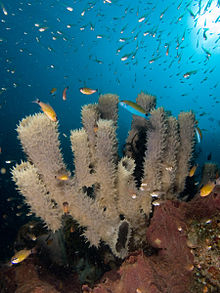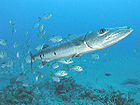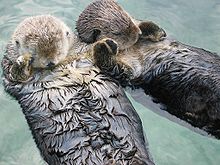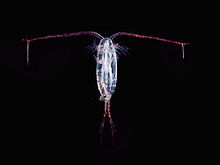- Marine biology
-
Marine biology is the scientific study of organisms in the ocean or other marine or brackish bodies of water. Given that in biology many phyla, families and genera have some species that live in the sea and others that live on land, marine biology classifies species based on the environment rather than on taxonomy. Marine biology differs from marine ecology as marine ecology is focused on how organisms interact with each other and the environment, and biology is the study of the organisms themselves.
Marine life is a vast resource, providing food, medicine, and raw materials, in addition to helping to support recreation and tourism all over the world. At a fundamental level, marine life helps determine the very nature of our planet. Marine organisms contribute significantly to the oxygen cycle, and are involved in the regulation of the Earth's climate.[1] Shorelines are in part shaped and protected by marine life, and some marine organisms even help create new land.[2]
Marine biology covers a great deal, from the microscopic, including most zooplankton and phytoplankton to the huge cetaceans (whales) which reach up to a reported 48 meters (125 feet) in length.
The habitats studied by marine biology include everything from the tiny layers of surface water in which organisms and abiotic items may be trapped in surface tension between the ocean and atmosphere, to the depths of the oceanic trenches, sometimes 10,000 meters or more beneath the surface of the ocean. It studies habitats such as coral reefs, kelp forests, tidepools, muddy, sandy and rocky bottoms, and the open ocean (pelagic) zone, where solid objects are rare and the surface of the water is the only visible boundary.
A large proportion of all life on Earth exists in the oceans. Exactly how large the proportion is unknown, since many ocean species are still to be discovered. While the oceans constitute about 71% of the Earth's surface, due to their depth they encompass about 300 times the habitable volume of the terrestrial habitats on Earth.
Many species are economically important to humans, including food fish. It is also becoming understood that the well-being of marine organisms and other organisms are linked in very fundamental ways. The human body of knowledge regarding the relationship between life in the sea and important cycles is rapidly growing, with new discoveries being made nearly every day. These cycles include those of matter (such as the carbon cycle) and of air (such as Earth's respiration, and movement of energy through ecosystems including the ocean). Large areas beneath the ocean surface still remain effectively unexplored.
Contents
Subfields
The marine ecosystem is large, and thus there are many sub-fields of marine biology. Most involve studying specializations of particular animal groups, such as phycology, invertebrate zoology and ichthyology.
Other subfields study the physical effects of continual immersion in sea water and the ocean in general, adaptation to a salty environment, and the effects of changing various oceanic properties on marine life. A subfield of marine biology studies the relationships between oceans and ocean life, and global warming and environmental issues (such as carbon dioxide displacement).
Recent marine biotechnology has focused largely on marine biomolecules, especially proteins, that may have uses in medicine or engineering. Marine environments are the home to many exotic biological materials that may inspire biomimetic materials.
Related fields
Marine biology is a branch of oceanography and is closely linked to biology. It also encompasses many ideas from ecology. Fisheries science and marine conservation can be considered partial offshoots of marine biology (as well as environmental studies).
Animals
Birds
Birds adapted to living in the marine environment are often referred to as seabirds. Examples include albatross, penguins, gannets, and auks. Although they spend most of their lives in the ocean, species such as gulls can often be found thousands of miles inland.
Fish
Fish anatomy includes a two-chambered heart, operculum, swim bladder, scales, fins, lips, eyes and secretory cells that produce mucous. Fish breathe by extracting oxygen from water through their gills. Fins propel and stabilize the fish in the water.
Well known fish include: sardines, anchovy, ling cod, clownfish (also known as anemonefish), and bottom fish which include halibut or ling cod. Predators include sharks and barracuda.
Invertebrates
As on land, invertebrates make up a huge portion of all life in the sea. Invertebrate sea life includes Cnidaria such as jellyfish and sea anemones; Ctenophora; sea worms including the phyla Platyhelminthes, Nemertea, Annelida, Sipuncula, Echiura, Chaetognatha, and Phoronida; Mollusca including shellfish, squid, octopus; Arthropoda including Chelicerata and Crustacea; Porifera; Bryozoa; Echinodermata including starfish; and Urochordata including sea squirts or tunicates.
Mammals
There are five main types of marine mammals.
- Cetaceans include toothed whales (Suborder Odontoceti), such as the Sperm Whale, dolphins, and porpoises such as the Dall's porpoise. Cetaceans also include baleen whales (Suborder Mysticeti), such as the Gray Whale, Humpback Whale, and Blue Whale.
- Sirenians include manatees, the Dugong, and the extinct Steller's Sea Cow.
- Seals (Family Phocidae), sea lions (Family Otariidae - which also include the fur seals), and the Walrus (Family Odobenidae) are all considered pinnipeds.
- The Sea Otter is a member of the Family Mustelidae, which includes weasels and badgers.
- The Polar Bear (Family Ursidae) is sometimes considered a marine mammal because of its dependence on the sea.
Reptiles
Reptiles which inhabit or frequent the sea include sea turtles, sea snakes, terrapins, the marine iguana, and the saltwater crocodile. Most extant marine reptiles, except for some sea snakes, are oviparous and need to return to land to lay their eggs. Thus most species, excepting sea turtles, spend most of their lives on or near land rather than in the ocean. Despite their marine adaptations, most sea snakes prefer shallow waters nearby land, around islands, especially waters that are somewhat sheltered, as well as near estuaries.[3][4] Some extinct marine reptiles, such as ichthyosaurs, evolved to be viviparous and had no requirement to return to land.
Fungi
Over 1500 species of fungi are known from marine environments.[5] These parasitize marine algae or animals, or are saprobes on algae, corals, protozoan cysts, sea grasses, wood and other substrata, and can also be found in sea foam.[6] Spores of many species have special appendages which facilitate attachment to the substratum.[7] A very diverse range of unusual secondary metabolites is produced by marine fungi.[8]
Plants and algae
Plant life is widespread and very diverse under the ocean. Microscopic photosynthetic algae contribute a larger proportion of the worlds photosynthetic output than all the terrestrial forests combined. Most of the niche occupied by sub plants on land is actually occupied by macroscopic algae in the ocean, such as Sargassum and kelp, which are commonly known as seaweeds that creates kelp forests. The non algae plants that survive in the sea are often found in shallow waters, such as the seagrasses (examples of which are eelgrass, Zostera, and turtle grass, Thalassia). These plants have adapted to the high salinity of the ocean environment. The intertidal zone is also a good place to find plant life in the sea, where mangroves or cordgrass or beach grass might grow. Microscopic algae and plants provide important habitats for life, sometimes acting as hiding and foraging places for larval forms of larger fish and invertebrates.
Microscopic life
Microscopic life undersea is incredibly diverse and still poorly understood. For example, the role of viruses in marine ecosystems is barely being explored even in the beginning of the 21st century.
The role of phytoplankton is better understood due to their critical position as the most numerous primary producers on Earth. Phytoplankton are categorized into cyanobacteria (also called blue-green algae/bacteria), various types of algae (red, green, brown, and yellow-green), diatoms, dinoflagellates, euglenoids, coccolithophorids, cryptomonads, chrysophytes, chlorophytes, prasinophytes, and silicoflagellates.
Zooplankton tend to be somewhat larger, and not all are microscopic. Many Protozoa are zooplankton, including dinoflagellates, zooflagellates, foraminiferans, and radiolarians. Some of these (such as dinoflagellates) are also phytoplankton; the distinction between plants and animals often breaks down in very small organisms. Other zooplankton include cnidarians, ctenophores, chaetognaths, molluscs, arthropods, urochordates, and annelids such as polychaetes. Many larger animals begin their life as zooplankton before they become large enough to take their familiar forms. Two examples are fish larvae and sea stars (also called starfish).
Marine habitats
Marine habitats 
Coral reefs provide marine habitats for tube sponges, which in turn become marine habitats for fishes
Littoral zone Intertidal zone Estuaries Kelp forests Coral reefs Ocean banks Continental shelf Neritic zone Straits Pelagic zone Oceanic zone Seamounts Hydrothermal vents Cold seeps Demersal zone Benthic zone Marine habitats can be divided into coastal and open ocean habitats. Coastal habitats are found in the area that extends from the shoreline to the edge of the continental shelf. Most marine life is found in coastal habitats, even though the shelf area occupies only seven percent of the total ocean area. Open ocean habitats are found in the deep ocean beyond the edge of the continental shelf
Alternatively, marine habitats can be divided into pelagic and demersal habitats. Pelagic habitats are found near the surface or in the open water column, away from the bottom of the ocean. Demersal habitats are near or on the bottom of the ocean. An organism living in a pelagic habitat is said to be a pelagic organism, as in pelagic fish. Similarly, an organism living in a demersal habitat is said to be a demersal organism, as in demersal fish. Pelagic habitats are intrinsically shifting and ephemeral, depending on what ocean currents are doing.
Marine habitats can be modified by their inhabitants. Some marine organisms, like corals, kelp and seagrasses, are ecosystem engineers which reshape the marine environment to the point where they create further habitat for other organisms.
Intertidal and shore
Intertidal zones, those areas close to shore, are constantly being exposed and covered by the ocean's tides. A huge array of life lives within this zone.
Shore habitats span from the upper intertidal zones to the area where land vegetation takes prominence. It can be underwater anywhere from daily to very infrequently. Many species here are scavengers, living off of sea life that is washed up on the shore. Many land animals also make much use of the shore and intertidal habitats. A subgroup of organisms in this habitat bores and grinds exposed rock through the process of bioerosion.
Reefs
Reefs comprise some of the densest and most diverse habitats in the world. The best-known types of reefs are tropical coral reefs which exist in most tropical waters; however, reefs can also exist in cold water. Reefs are built up by corals and other calcium-depositing animals, usually on top of a rocky outcrop on the ocean floor. Reefs can also grow on other surfaces, which has made it possible to create artificial reefs. Coral reefs also support a huge community of life, including the corals themselves, their symbiotic zooxanthellae, tropical fish and many other organisms.
Much attention in marine biology is focused on coral reefs and the El Niño weather phenomenon. In 1998, coral reefs experienced the most severe mass bleaching events on record, when vast expanses of reefs across the world died because sea surface temperatures rose well above normal.[9][10] Some reefs are recovering, but scientists say that between 50% and 70% of the world's coral reefs are now endangered and predict that global warming could exacerbate this trend.[11][12][13][14]
Open ocean
The open ocean is relatively unproductive because of a lack of nutrients, yet because it is so vast, in total it produces the most primary productivity. Much of the aphotic zone's energy is supplied by the open ocean in the form of detritus. The open ocean consists mostly of jellyfish and its predators such as the mola mola.
Deep sea and trenches
The deepest recorded oceanic trenches measure to date is the Mariana Trench, near the Philippines, in the Pacific Ocean at 10,924 m (35,838 ft). At such depths, water pressure is extreme and there is no sunlight, but some life still exists. A white flatfish, a shrimp and a jellyfish were seen by the American crew of the bathyscaphe Trieste when it dove to the bottom in 1960.[15]
Other notable oceanic trenches include Monterey Canyon, in the eastern Pacific, the Tonga Trench in the southwest at 10,882 m (35,702 ft), the Philippine Trench, the Puerto Rico Trench at 8,605 m (28,232 ft), the Romanche Trench at 7,760 m (24,450 ft), Fram Basin in the Arctic Ocean at 4,665 m (15,305 ft), the Java Trench at 7450 m (24,442 ft), and the South Sandwich Trench at 7,235 m (23,737 ft).
In general, the deep sea is considered to start at the aphotic zone, the point where sunlight loses its power of transference through the water.[citation needed] Many life forms that live at these depths have the ability to create their own light known as bio-luminescence.
Marine life also flourishes around seamounts that rise from the depths, where fish and other sea life congregate to spawn and feed. Hydrothermal vents along the mid-ocean ridge spreading centers act as oases, as do their opposites, cold seeps. Such places support unique biomes and many new microbes and other lifeforms have been discovered at these locations .[citation needed]
Distribution factors
An active research topic in marine biology is to discover and map the life cycles of various species and where they spend their time. Marine biologists study how the ocean currents, tides and many other oceanic factors affect ocean lifeforms, including their growth, distribution and well-being. This has only recently become technically feasible with advances in GPS and newer underwater visual devices.[citation needed]
Most ocean life breeds in specific places, nests or not in others, spends time as juveniles in still others, and in maturity in yet others. Scientists know little about where many species spend different parts of their life cycles. For example, it is still largely unknown where sea turtles and some sharks travel. Tracking devices do not work for some life forms, and the ocean is not friendly to technology. This is important to scientists and fishermen because they are discovering that by restricting commercial fishing in one small area they can have a large impact in maintaining a healthy fish population in a much larger area far away.
See also
Lists
- Glossary of ecology
- Index of biology articles
- Large marine ecosystem
- List of ecologists
- List of marine biologists
- List of marine ecoregions (WWF)
- Outline of biology
- Outline of ecology
References
- ^ Foley, Jonathan A.; Karl E. Taylor, Steven J. Ghan (1991). "Planktonic dimethylsulfide and cloud albedo: An estimate of the feedback response". Climatic Change 18 (1): 1. doi:10.1007/BF00142502. http://www.springerlink.com/content/hm3h1q666x206h46.
- ^ Sousa, Wayne P (1986) [1985]. "7, Disturbance and Patch Dynamics on Rocky Intertidal Shores". The Ecology of Natural Disturbance and Patch Dynamics. eds. Steward T. A. Pickett & P. S. White. Academic Press. ISBN 0125545215. http://books.google.co.uk/books?id=jIj-qAflWxQC&pg=PA101&dq=patch+dynamics+shoreline.
- ^ Stidworthy J. 1974. Snakes of the World. Grosset & Dunlap Inc. 160 pp. ISBN 0-448-11856-4.
- ^ Sea snakes at Food and Agriculture Organization of the United Nations. Accessed 7 August 2007.
- ^ Hyde, K.D.; E.B.J. Jones, E. Leaño, S.B. Pointing, A.D. Poonyth, L.L.P. Vrijmoed (1998). "Role of fungi in marine ecosystems". Biodiversity and Conservation 7 (9): 1147–1161.
- ^ Kirk, P.M., Cannon, P.F., Minter, D.W. and Stalpers, J. "Dictionary of the Fungi". Edn 10. CABI, 2008
- ^ Hyde, K.D.; E.B.J. Jones (1989). "Spore attachment in marine fungi". Botanica Marina 32: 205–218.
- ^ San-Martín, A.; S. Orejanera, C. Gallardo, M. Silva, J. Becerra, R. Reinoso, M.C. Chamy, K. Vergara, J. Rovirosa (2008). "Steroids from the marine fungus Geotrichum sp.". Journal of the Chilean Chemical Society 53 (1): 1377–1378.
- ^ NOAA (1998) Record-breaking coral bleaching occurred in tropics this year. National Oceanic and Atmospheric Administration, Press release (October 23, 1998).
- ^ ICRS (1998) Statement on Global Coral Bleaching in 1997-1998. International Coral Reef Society, October 15, 1998.
- ^ Bryant, D., Burke, L., McManus, J., et al. (1998) "Reefs at risk: a map-based indicator of threats to the world's coral reefs". World Resources Institute, Washington, D.C.
- ^ Goreau, T. J. (1992) "Bleaching and Reef Commumity Change in Jamaica: 1951 - 1991". Amer. Zool. 32: 683-695.
- ^ Sebens, K. P. (1994) "Biodiversity of Coral Reefs: What are We Losing and Why?" Amer Zool, 34: 115-133
- ^ Wilkinson, C. R., and Buddemeier, R. W. (1994) "Global Climate Change and Coral Reefs:Implications for People and Reefs". Report of the UNEP-IOC-ASPEI-IUCN Global Task Team on the Implications of Climate Change on Coral Reefs. IUCN, Gland, Switzerland.
- ^ Seven Miles Down: The Story of The Bathyscaph Trieste., Rolex Deep Sea Special, January 2006.
External links
- Smithsonian Ocean Portal
- Marine Conservation Society
- Marine biology at the Open Directory Project
- Marine Ecology - an evolutionary perspective
- Free special issue: Marine Biology in Time and Space
Branches of Biology Anatomy · Astrobiology · Biochemistry · Biogeography · Biomechanics · Biophysics · Bioinformatics · Biostatistics · Botany · Cell biology · Cellular microbiology · Chemical biology · Chronobiology · Conservation biology · Developmental biology · Ecology · Epidemiology · Epigenetics · Evolutionary biology · Genetics · Genomics · Histology · Human biology · Immunology · Marine biology · Mathematical biology · Microbiology · Molecular biology · Mycology · Neuroscience · Nutrition · Origin of life · Paleontology · Parasitology · Pathology · Pharmacology · Physiology · Quantum biology · Systematics · Systems biology · Taxonomy · Toxicology · ZoologyFisheries science and wild fisheries Fisheries science - Population dynamics of fisheries
- Shifting baseline
- Fish stock
- Fish mortality
- Stock assessment
- Fish measurement
- Fish counter
- Data storage tag
- Biomass
- Fisheries acoustics
- Acoustic tag
- GIS and aquatic science
- EcoSCOPE
- Age class structure
- Trophic level
- Trophic cascades
- Match/mismatch hypothesis
- Fisheries and climate change
- Marine biology
- Aquatic ecosystems
- Bioeconomics
- EconMult
- Ecopath
- FishBase
- Census of Marine Life
- OSTM
- Fisheries databases
- Institutes
- Fisheries scientists

Wild fisheries - Ocean fisheries
- Diversity of fish
- Coastal fish
- Coral reef fish
- Demersal fish
- Forage fish
- Pelagic fish
- Cod fisheries
- Crab fisheries
- Eel fisheries
- Krill fisheries
- Kelp fisheries
- Lobster fisheries
- Shrimp fisheries
- Eel ladder
- Fish ladder
- Fish screen
- Migration
- Sardine run
- Shoaling and schooling
- Marine habitats
- Marine snow
- Water column
- Upwelling
- Humboldt current
- Algal blooms
- Dead zones
- Fish kill
Fisheries management, sustainability and conservation Management 
Quotas Sustainability - Sustainable fisheries
- Maximum sustainable yield
- Sustainable seafood
- Overfishing
- Environmental effects of fishing
- Fishing down the food web
- Destructive fishing practices
- Future of Marine Animal Populations
- The Sunken Billions
- End of the Line
Conservation - Marine Protected Area
- Marine reserve
- Marine conservation
- Marine conservation activism
- Salmon conservation
- Grey nurse shark conservation
- Shark sanctuary
Organisations - Marine Stewardship Council
- Friend of the Sea
- SeaChoice
- Seafood Watch
- Oceana
- Sea Around Us Project
- WorldFish Center
- Defying Ocean's End
- HERMIONE
- PROFISH
- International Seafood Sustainability Foundation
- Sea Shepherd Conservation Society
- Greenpeace
Related issues - List of fishing topics by subject
- Index of fishing articles
- Fisheries glossary
Categories:- Marine biology
- Biological oceanography
- Fisheries
Wikimedia Foundation. 2010.








